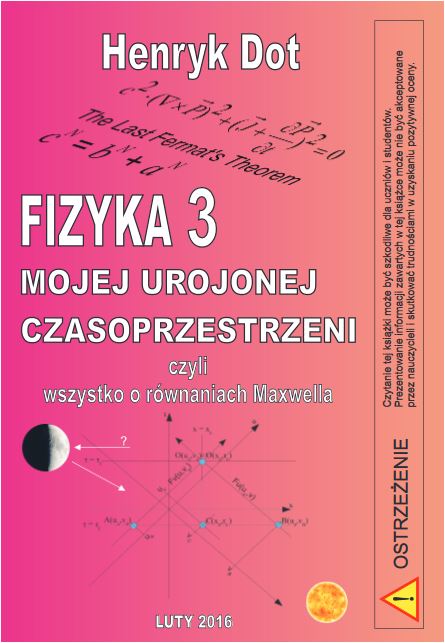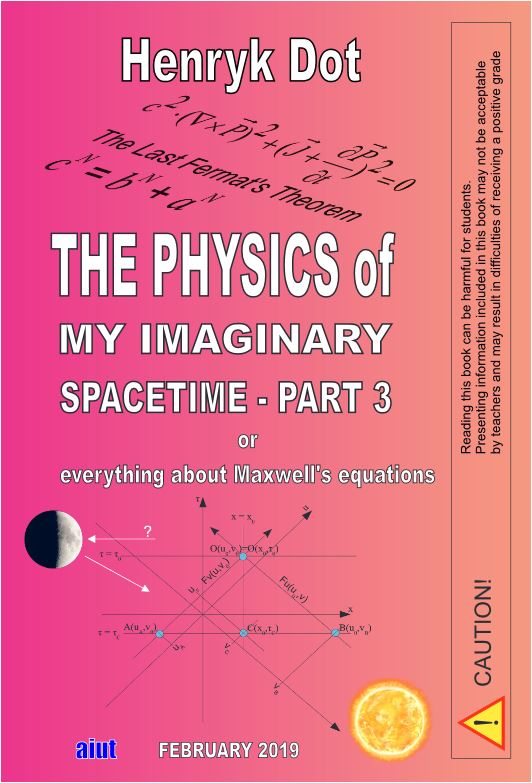★ HenrykDot.com
★
is the online companion to a series of books published by AIUT under the common main title
"Physics of My Imaginary Space-Time" by Henryk Dot.
is the online companion to a series of books published by AIUT under the common main title
"Physics of My Imaginary Space-Time" by Henryk Dot.
Home
Physics 3 - Maxwell
Note from the Author
Table of Contents
What is this book
Historical facts
New aspects
Fully erroneous
Incorrectly interpreted
Physics 3 - Chapter 1
Equations
Complex vectors form
The Most General form
The General Solution
Physics 3 - Chapter 2
Solutions
Initial conditions
Non-homogeneous equation
Solution for three-directions
The four laws
Physics 3 - Supplement
Fermat's proof
Beal's conjecture
Pythagorean triples
Inertial mass
Gravity constans big G
What does the Moon look at?
Physics 3 - Final notes
Final notes
Physics 4 - New book
Entry
Physics 3 - Maxwell
Note from the Author
Table of Contents
What is this book
Historical facts
New aspects
Fully erroneous
Incorrectly interpreted
Physics 3 - Chapter 1
Equations
Complex vectors form
The Most General form
The General Solution
Physics 3 - Chapter 2
Solutions
Initial conditions
Non-homogeneous equation
Solution for three-directions
The four laws
Physics 3 - Supplement
Fermat's proof
Beal's conjecture
Pythagorean triples
Inertial mass
Gravity constans big G
What does the Moon look at?
Physics 3 - Final notes
Final notes
Physics 4 - New book
Entry
Contact
email: henryk.dot(at)aiut.com
"Subject" should begin with
a digit corresponding to the day
of the week., e.g. Sunday=7
"Subject" should begin with
a digit corresponding to the day
of the week., e.g. Sunday=7
Books published by AIUT
are found in libraries according to the list of compulsory copies.
Second Edition of "Fizyka 3"
ISBN 978-83-926856-1-6

can be bought in Warsaw
in the Academic Bookstore
PW Publishing House
Noakowskiego street 18/20
and in Katowice
in the bookstore "Liber"
Bankowa street 11.
(area of Silesian University)
English edition of "Physics"
ISBN 978-83-926856-2-3

is also in libraries
and the distribution method should be asked wydawca@aiut.com.
|
General solution of Maxwell’s equations is regarded here as a conversion of equation (1.33) to a classical textbook form of partial differential equations. So far, for this purpose the Lorenz’ gauge has been applied (e.g. Feynman, Griffiths). It is presented in this chapter that use of disadvantageous Lorenz’ gauge is not needed; simpler and better method can be applied. Equation (1.33) can be transformed using two methods, both yielding the same result. First method is to differentiate both sides of equation (1.33) with respect to time τ so we obtain: | |
|
|
(1.36) |
| and after changing the order of differentiation on the left side: | |
|
|
(1.37) |
|
then using value of
| |
|
|
(1.38) |
| Second method – calculating a curl of both sides of equation (1.33), we obtain: | |
|
|
(1.39) |
| and after changing the order of differentiation, this time on the right side: | |
|
|
(1.40) |
| where we can use the value of ∇╳ P⃗ calculated from (1.33) so we have: | |
|
|
(1.41) |
| In both cases we obtain: | |
|
|
(1.42) |
|
Then use of
| |
|
|
(1.43) |
|
which can be considered as general solution of Maxwell’s equations, since it presents Maxwell’s equations
in a basic form of differential equations; on the left-side we have unknown function and its derivatives
and on the right-side forcing functions, in our case sources. . Equation (1.43) contains separated formulas for fields E and B, which is more transparent after expressing it in two separate equations – for real and imaginary parts: . | |
|
|
(1.44) |
|
|
(1.45) |
|
These two formulas are fully independent without additional limitations which
are imposed by using Lorenz’ gauge, and relate to the most general mathematical form of Maxwell’s equations,
i.e. including magnetic monopole and magnetic current. We can omit solutions for magnetic monopole and magnetic current sources, although such solutions can be easily derived from similar solutions obtained for electric field. The following equations then remain: | |
|
|
(1.46) |
|
|
(1.47) |
|
| |
© 2020 Henryk Dot -
